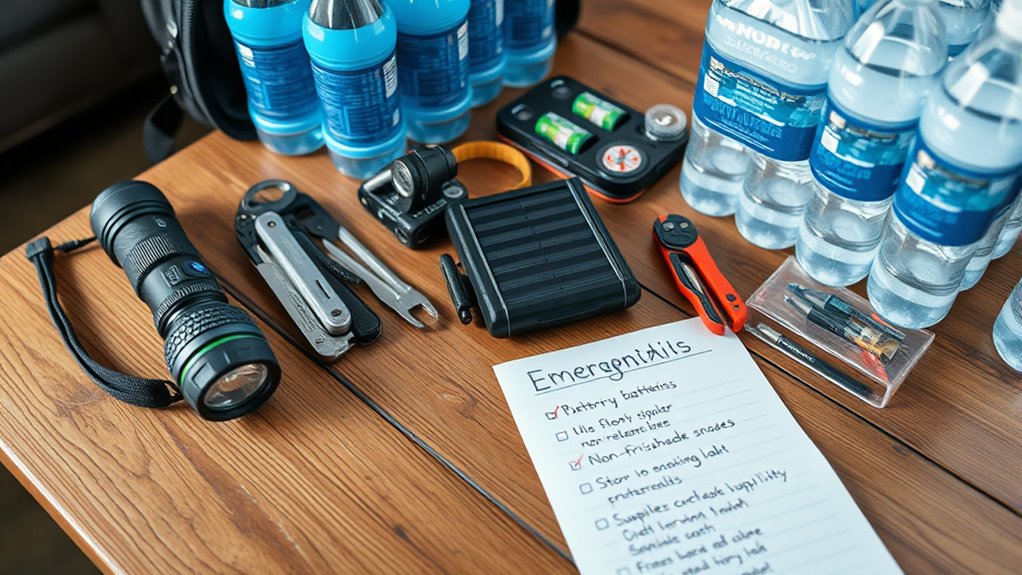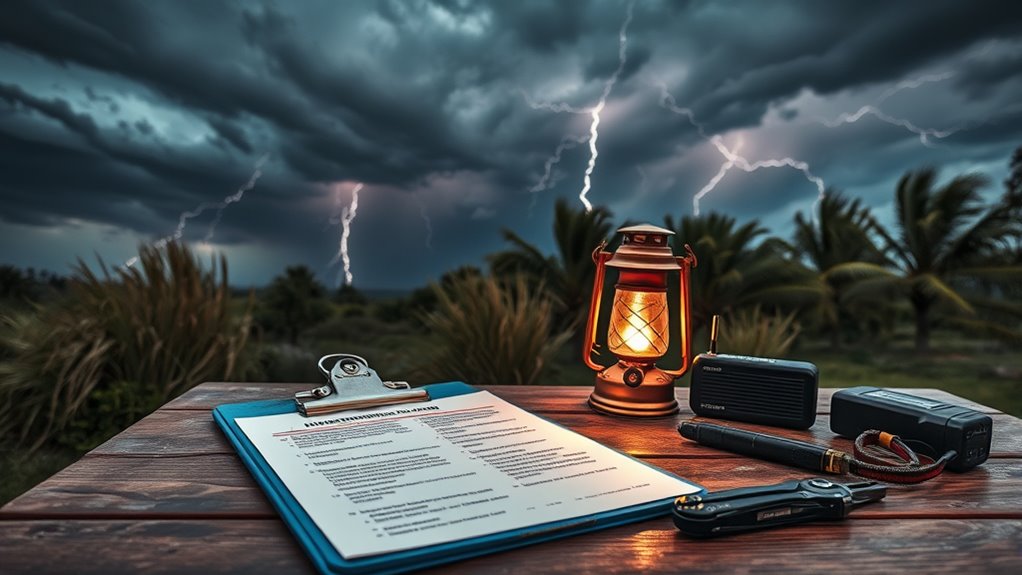To prepare for storm outages, gather essential tools like portable generators, backup batteries, and extension cords. Create a clear safety and communication plan by updating contacts, identifying safe meeting spots, and practicing protocols regularly. Maintain your home’s power resilience by scheduling generator maintenance, considering solar backups, and keeping equipment clean and functional. Staying proactive with these steps builds confidence and safety during storms. If you want to learn more, discover additional tips to strengthen your storm preparedness.
Key Takeaways
- Regularly test and maintain backup power systems like generators and solar batteries to ensure reliability during outages.
- Create and practice a comprehensive communication and safety plan with family and neighbors before storm season.
- Stockpile essential supplies including batteries, extension cords, flashlights, and first aid kits for quick access during outages.
- Keep emergency contact information and safety protocols easily accessible and update them regularly.
- Stay informed on new technologies and professional services to enhance your home’s power resilience and outage preparedness.
Essential Tools and Supplies for Power Outages

Having the right tools and supplies ready is vital when preparing for power outages during storm season. Portable generators are a dependable way to keep essential appliances running, especially during extended outages. Make sure yours is fueled and in good working condition before storms arrive. Backup batteries are also indispensable; they can power small devices like flashlights, radios, and cell phones, guaranteeing you stay informed and connected. Stock up on extra batteries as well, so you won’t be caught unprepared. Additionally, keep extension cords, flashlights, and a first aid kit accessible. Having these tools on hand helps maintain safety and communication, reducing stress during outages. Proper preparation ensures you’re ready to handle power disruptions confidently and efficiently. Incorporating smart device solutions can further enhance your outage preparedness by automating certain functions and monitoring system health.
Creating a Communication and Safety Plan

How can you guarantee everyone stays safe and informed during a storm-related power outage? The key is creating a solid communication and safety plan. Start by updating and sharing emergency contacts with all family members and neighbors. Make sure everyone knows how to reach each other, even without power. Establish safety protocols, such as staying indoors, avoiding downed wires, and using flashlights safely. Designate a central meeting spot if you need to evacuate. Keep a list of emergency contacts accessible, including local authorities, utility companies, and medical providers. Practice your plan regularly so everyone understands their roles. Clear communication and well-understood safety protocols help prevent confusion, reduce panic, and keep everyone safe during storm outages. Additionally, understanding the disadvantages of eye patches can be useful if you or family members use them as part of your self-care routine during stressful times.
Tips for Maintaining Your Home’s Power Resilience

To keep your home’s power resilient during storm season, it’s essential to take proactive measures that minimize outages and protect your electrical system. Regular generator maintenance guarantees your backup power source functions reliably when needed. Schedule professional inspections and test your generator periodically to identify potential issues before storms hit. Consider installing a solar backup system to reduce dependence on the grid and provide clean, renewable energy during outages. Keep batteries charged and components clean to maximize efficiency. Additionally, clear debris around your solar panels and generator to prevent obstructions. By maintaining your generator and investing in solar backup technology, you boost your home’s resilience, ensuring continuous power and peace of mind during storm season. Proper load‑planning tools can help you determine the right backup capacity for your home’s needs.
Frequently Asked Questions
How Can I Tell if My Home’s Electrical System Is Storm-Resistant?
You can tell if your home’s electrical system is storm-resistant by checking for storm-resistant features like surge protectors, grounding systems, and weatherproof electrical enclosures. Guarantee your home electrical safety includes regular inspections by a professional to identify vulnerabilities. Look for outdoor outlets with weatherproof covers and verify that your electrical panel is properly grounded. These features help protect your home during storms and minimize electrical damage.
What Are the Legal Requirements for Generator Installation in My Area?
Think of your home as a fortress needing proper defenses. You must obtain local permits and follow safety regulations before installing a generator, ensuring your fortress is storm-proof. Check with your local authorities or utility company to understand specific legal requirements. Failing to meet these can lead to fines or safety hazards, so prioritize obtaining permits and adhering to safety standards to protect your home and loved ones during storm season.
How Often Should I Review and Update My Outage Plan?
You should review and update your outage plan at least once a year, ideally before storm season begins. During this process, follow your maintenance schedule to guarantee all equipment is functioning properly. Conduct emergency drills with your team to identify potential gaps and improve response times. Regular reviews and drills keep your plan current, effective, and ready to minimize disruption when outages occur, giving you peace of mind during storm season.
Are There Specific Insurance Policies That Cover Storm-Related Power Outages?
Yes, certain insurance policies cover storm-related power outages, but you need to check your policy details carefully. Look for coverage labeled as “additional living expenses” or “business interruption,” which may help with costs during outages. Contact your insurer to confirm what’s included, as coverage varies. Ensuring you understand your insurance coverage before storm season helps you prepare and avoid surprises when outages occur.
What Are the Common Mistakes to Avoid During Storm Season Preparations?
Did you know that nearly 60% of storm-related accidents happen due to poor preparedness? To stay safe, avoid common mistakes like neglecting storm safety protocols or not updating your emergency contacts. Always review your emergency plans, keep supplies stocked, and make certain your communication devices work. Staying proactive helps you respond quickly, reducing risks during power outages. Don’t wait until the storm hits—prepare now to protect yourself and loved ones.
Conclusion
Just as ancient mariners relied on careful navigation to survive storms, your preparedness guarantees you weather power outages with confidence. By assembling essential supplies, establishing clear communication plans, and fortifying your home’s resilience, you emulate those who navigated tempests before you. Remember, proactive planning isn’t just about avoiding trouble — it’s about steering your household safely through the darkest skies, emerging stronger on the other side, much like the dawn after a long night.









